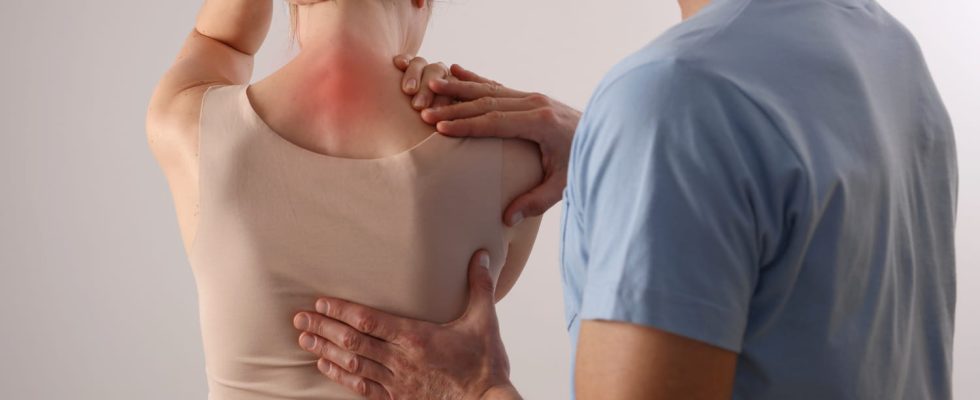The upper part of the back is naturally curved, but if this curvature becomes pathological, we speak of dorsal hyperkyphosis. By misnomer, we sometimes speak of kyphosis to designate hyperkyphosis and it can be corrected.
Kyphosis is the name given to the natural curvature of the spine at the upper back. It concerns the beginning of the thoracic vertebrae and produces a posterior curvature, in opposition to the anterior curvatures of the spine (lordosis) which are also physiological at the level of the cervical vertebrae (at the neck) and the lumbar vertebrae (at the lower back). Dorsal kyphosis gives the back a slightly rounded posture. When the dorsal curvature is exaggerated, we speak ofhyperkyphosis. By shorthand, we sometimes speak of kyphosis to designate hyperkyphosis..
What are the symptoms ?
Hyperkyphosis manifests itself by:
- An exaggerated curvature of the upper part of the back which can cause the appearance of a bump ;
- Pains sometimes next to this area.
What is this due to?
Hyperkyphosis can be due to spinal malformations, neurological diseases or occur in the development of rheumatic diseases. If the malformation is significant, the person with hyperkyphosis has a shortened waist, a curved back with the head tilted forward. Kyphosis may be associated with a lateral deviation of the spine, called scoliosis. The character of Quasimodo or the “hunchback” are examples of very severe kyphoscoliosis. The main causes of hyperkyphosis are:
► Scheuermann’s disease which is a most often benign disease of the growth of the vertebrae. It can be responsible for kyphoscoliosis during growth spurts in adolescents. It mainly affects tall boys;
► Sarcopenia: “the natural and physiological loss of muscle mass leads to a sagging of muscle mass which can lead to spinal deformities, indicates Professor Aleth Perdriger. And this is especially true if there are underlying pathologies that affect the vertebral disc such as chondrocalcinosis, which is a benign cartilage disease that can affect the spine.”
► Osteoporosis: osteoporosis can be complicated by vertebral fractures, which contributes to accentuating classic kyphosis of the back and making it pathological;
► Ankylosing spondylitis: this inflammatory disease which affects the spine and which can be responsible for kyphosis;
► Inflammatory or genetic myopathies which are responsible for an insufficiency of the back muscles and which promotes curvature of the spine, or even camptocormia which is characterized by the fact of being leaned forward and no longer able to straighten up.
In the case of kyphosis, a physical exam will allow us to suspect it and A radiograph allows a diagnosis to be made and the extent of the curvature to be quantified. In cases of painful kyphosis in adolescents, intraspongy hernias are visible on the x-ray.
What are the consequences of kyphosis?
Kyphosis hinders mobility and can be responsible for breathing difficulties. “In fact, breathing is carried out thanks to the mobility of the ribs which will widen to allow the lungs to expand. In the context of kyphosis, expansion will take place less well, which causes a restrictive pulmonary syndrome. Hyperkyphosis also causes a shortening of the waist, the back is hunched and the head tilts forward. develops the rheumatologist.
Does it get worse with age?
“Kyphosis naturally tends to increase with age because the spinal discs become dehydrated, more rigid, less mobile and less thick. The loss of muscle and the reduction in the quality of the muscle fiber also favor this phenomenon. This is why many older people have their heads tilted forward and their backs hunched.”explains the specialist.
When growth is not complete, one can resort to when wearing a corset which will help keep the back in a good position. Stopping sports and banning carrying heavy loads add to these recommendations. The person may also have physiotherapy or rehabilitative gymnastics sessions. In older people with hyperkyphosis, the deformity is often too advanced for corrective treatment to be carried out. When kyphosis is not due to an illness, congenital malformation, trauma or accident, but to poor posture and excess heavy loads damaging the back, its occurrence can be prevented by correcting bad habits in time. . “At a later age, the treatment of kyphosis is based on three elements : THE muscle strengtheningrespiratory amplitude and prevention of osteoporosis. Stretching the spine will help limit kyphosis and the consumption of vitamin D and calcium will help reduce the risk of osteoporosis.specifies Professor Aleth Perdriger.
Thanks to Professor Aleth Perdriger, rheumatologist
